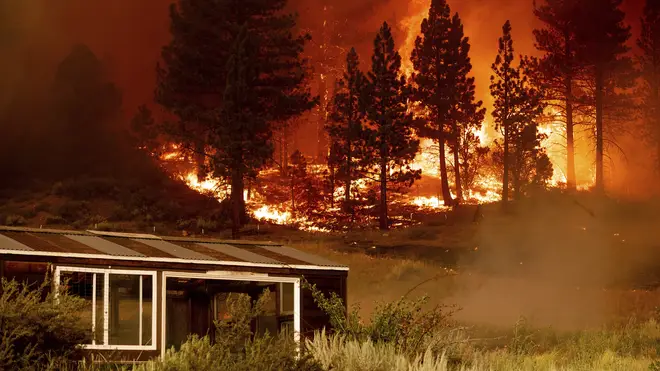
Ian Payne 4am - 7am
22 July 2021, 17:24

Improved conditions are helping crews fight the large Bootleg Fire in southern Oregon.
A Northern California wildfire prompted evacuations after crossing into Nevada as crews continue to battle a mammoth blaze in southern Oregon.
The Tamarack Fire south of Lake Tahoe had burned more than 68 square miles (176 square kilometres) of timber and head-high chaparral in national forest land on Wednesday.
It erupted on July 4 and was one of nearly two dozen blazes sparked by lightning strikes.
More than 1,200 firefighters were battling the Alpine County blaze, which has destroyed at least 10 buildings.

To the northwest, the summer fun of boating and bathing came to an abrupt end for vacationers at Lake Almanor as the Dixie Fire spread up the west flank of the Sierra Nevada, expanding to more than 162 square miles. The west shore of the resort lake and many other small communities were under evacuation orders.
Fire officials expected active or extreme fire behaviour on Thursday, which could see 14-mph winds and temperatures approaching 90 degrees Fahrenheit (32 C).
Mandatory evacuations were ordered for several communities and a request for voluntary evacuations was issued for portions of Douglas County, Nevada.
An evacuation centre was set up at a community centre in Gardnerville, Nevada.
Meanwhile, Oregon on Wednesday banned all campfires on state-managed lands and in state campgrounds east of Interstate 5, the major highway that is commonly considered the dividing line between the wet western part of the state and the dry eastern half.
The nation’s largest wildfire, Oregon’s Bootleg Fire, grew to 624 square miles (1,616 square kilometres) — more than half the size of Rhode Island.
However, authorities said lower winds and temperatures allowed crews to improve fire lines.

The fire also was approaching an area burned by a previous fire on its active southeastern flank, raising hopes that lack of fuel could reduce its spread.
The Oregon fire, which was sparked by lightning, has ravaged the sparsely populated southern part of the state and had been expanding by up to four miles (six kilometres) a day, pushed by strong winds and critically dry weather that turned trees and undergrowth into a tinderbox.
Fire crews have had to retreat from the flames for 10 consecutive days. Monstrous clouds of smoke and ash have risen up to six miles (10 kilometres) into the sky and are visible for more than 100 air miles (161 kilometres).
The blaze, which is being fought by more than 2,200 people, is about one-third contained.
At least 2,000 homes were ordered evacuated at some point during the fire and an additional 5,000 were threatened. At least 70 homes and more than 100 outbuildings have burned, but no one is known to have died.
Extremely dry conditions and recent heat waves tied to climate change have made wildfires harder to fight.
Climate change has made the West much warmer and drier in the past 30 years and will continue to make weather more extreme and wildfires more frequent and destructive.